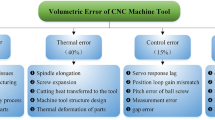Abstract
Off-line programming systems are essential tools for the effective use of robots in the manufacturing environment. This paper presents a dedicated off-line programming system for robotic drilling in aerospace manufacturing. Following a brief introduction of the system architecture, the paper discusses two major problems of off-line programming for robotic drilling, i.e., redundancy resolution and position correction. A new performance index is proposed for the combined requirements of singularity and joint-limit avoidance, followed by a discussion of the redundancy resolution scheme by using numerical optimization at the joint displacement level. A position correction method using measurement data of reference holes is developed for the enhancement of robotic drilling accuracy. Robot programs generated by using the developed system have been tested on a robotic drilling system, and the experimental results are provided.
Similar content being viewed by others
References
DeVlieg R, Szallay Todd (2010) Applied accurate robotic drilling for aircraft fuselage. SAE Technical Papers 2010-01-1836
Zhan Q, Wang J (2011) Hand–eye calibration and positioning for a robot drilling system. Int J Adv Manuf Technol 61(5–8):691–701
Liang J, Bi SS (2010) Design and experimental study of an end effector for robotic drilling. Int J Adv Manuf Technol 50:399–407
Bi SS, Liang J (2011) Robotic drilling system for titanium structures. Int J Adv Manuf Technol 54:767–774
DeVlieg R, Sitton K, Feikert E, Inman J (2002) ONCE (one sided cell end effector) robotic drilling system. In: SAE 2002 Automated Fastening Conference & Exposion, Chester, ENGLA. SAE Technical Papers 2002-01-2626
Devlieg R, Feikert E (2008) One-up assembly with robots. In: SAE 2008 Aerospace Manufacturing and Automated Fastening Conference & Exhibition, North Charleston, SC, USA. SAE Technical Papers 2008-01-2297
Atkinson J, Hartmann J, Jones S, Gleeson P (2007) Robotic drilling system for 737 Aileron. In: SAE 2007 AeroTech Congress & Exhibition, Los Angeles, CA, USA. SAE Technical Papers 2007-01-3821
Webb P, Eastwood S, Jayaweera N, Chen Y (2005) Automated aero structure assembly. Ind Robot 32:383–387
Olsson T, Haage M, Kihlman H, Johansson R, Nilsson K, Robertsson A, Björkman M, Isaksson R, Ossbahr G, Brogårdh T (2010) Cost-efficient drilling using industrial robots with high-bandwidth force feedback. Robot Comput Integr Manuf 26:24–38
Craig JJ (2004) Introduction to robotics: mechanics and control, 3rd edn. Pearson Prentice Hall, Upper Saddle River, NJ
Mitsi S, Bouzakis KD, Mansour G, Sagris D, Maliaris G (2005) Off-line programming of an industrial robot for manufacturing. Int J Adv Manuf Technol 26:262–267
Pan Z, Polden J, Larkin N, Duin SV, Norrish J (2011) Recent Progress on Programming Methods for Industrial Robots. Robot Comput Integr Manuf 28(2):87–94
Huo L, Baron L (2008) The joint-limits and singularity avoidance in robotic welding. Ind Robot: Int J 35(5):456–464
Zanchettin AM, Rocco P, Robertsson A, Johansson R (2011) Exploiting task redundancy in industrial manipulators during drilling operations. In 2011 IEEE International Conference on Robotics and Automation, Shanghai, China
Zargarbashi SHH, Khan W, Angeles J (2012) Posture optimization in robot-assisted machining operations. Mech Mach Theory 51:74–86
Huo L, Baron L (2011) The self-adaption of weights for joint-limits and singularity avoidances of functionally redundant robotic-task. Robot Comput Integr Manuf 27:367–376
Andres J, Gracia L, Tornero J (2012) Implementation and testing of a CAM postprocessor for an industrial redundant workcell with evaluation of several fuzzified Redundancy Resolution Schemes. Robot Comput Integr Manuf 28:265–274
Yoshikawa T (1985) Manipulability of robotic mechanisms. Int J Rob Res 4(2):3–9
Angeles J (2003) Fundamentals of robotic mechanical systems: theory, methods and algorithms. Springer, New York
Dumas C, Caro S, Carnier S, Furet B (2011) Joint stiffness identification of six-revolute industrial serial robots. Rob Comput Integr Manuf 27:881–888
Chaumette F, Marchand E (2001) A redundancy-based iterative approach for avoiding joint limits: application to visual servoing. IEEE Trans Robot Autom 17(5):719–730
Press W, Teukolsky SA, Vetterling WT, Flannery BP (1992) Numerical Recipes in C. Cambridge University Press, Cambridge
Author information
Authors and Affiliations
Corresponding author
Rights and permissions
About this article
Cite this article
Zhu, W., Qu, W., Cao, L. et al. An off-line programming system for robotic drilling in aerospace manufacturing. Int J Adv Manuf Technol 68, 2535–2545 (2013). https://doi.org/10.1007/s00170-013-4873-5
Received:
Accepted:
Published:
Issue Date:
DOI: https://doi.org/10.1007/s00170-013-4873-5




